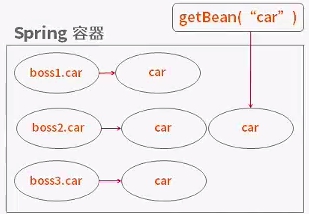spring的配置文件概述
簡(jiǎn)介
spring的配置文件是用于指導(dǎo)spring工廠進(jìn)行bean生成、依賴關(guān)系注入及bean示例分發(fā)的”圖紙”,他是一個(gè)或多個(gè)標(biāo)磚的xml文檔,j2ee程序員必須學(xué)會(huì)靈活應(yīng)用這份”圖紙”,準(zhǔn)確的表達(dá)自己的”生成意圖”。
spring配置文件的示例
spring配置文件的一般結(jié)構(gòu)

spring容器高層視圖
spring容器啟動(dòng)基本條件:
spring的框架類包
bean的配置信息
bean的元數(shù)據(jù)信息
bean的實(shí)現(xiàn)類

bean的屬性信息
例如:數(shù)據(jù)源的用戶名、密碼
bean的依賴關(guān)系
spring根據(jù)依賴關(guān)系配置完成bean之間的裝配
bean的行為配置
例如:生命周期范圍、生命周期各個(gè)過程的回調(diào)函數(shù)
bean的創(chuàng)建方式
說明bean是通過構(gòu)造器還是工廠方法來創(chuàng)建的
bean的實(shí)現(xiàn)類
基于xml的配置
spring的配置文件是基于xml格式的,spring1.0的配置采用dtd格式,spring2.0以后使用schema的格式,后者讓不同類型的配置擁有了自己的命名空間,是配置文件更具有擴(kuò)展性。
xml分析
|
1
2
3
4
5
6
7
8
9
10
11
12
13
|
<?xml version="1.0" encoding="utf-8"?><beansxmlns="http://www.springframework.org/schema/beans"xmlns:xsi="http://www.w3.org/2001/xmlschema-instance"xmlns:aop="http://www.springframework.org/schema/aop"xsi:schemalocation="http://www.springframework.org/schema/beans http://www.springframework.org/schema/beans/spring-beans.xsdhttp://www.springframework.org/schema/aop http://www.springframework.org/schema/aop/spring-aop-3.0.xsd"><bean id="saleproduct" class="com.sale.entity.saleproduct" ></bean><aop:config><aop:pointcut expression="execution(* com.sale.service.*.*(..))" id="mycut"/></aop:config></beans> |
xmlns="":表示默認(rèn)命空間,用于spring bean定
xmlns:xsi="http://www.w3.org/2001/xmlschema-instance":表示xsi標(biāo)準(zhǔn)命名空間,用于指定自定義命名空間的schema文件
xmlns:aop="":表示自定義命名空間,aop表示該命名空間的簡(jiǎn)稱
xsi:schemalocation="
">:用于為每個(gè)命名空間指定具體的schema文件
<bean id="saleproduct" class="com.sale.entity.saleproduct" ></bean>:為默認(rèn)命名空間中的配置
<aop:config>
<aop:pointcut expression="execution(* com.sale.service.*.*(..))" id="mycut"/>
</aop:config>:為aop命名空間的配置
schema文件的用途
spring3.0的配置schema文件分部在各模塊類包中,如果模塊擁有對(duì)應(yīng)的schema文件,則可以在模塊類包中找到一個(gè)config目錄,schema文件就為與該目錄中,如下是對(duì)這些schema文件的用途:
示例說明:spring-aop-3.0.xsd
命名空間:
schema文件:
1. spring-beans.xsd :用于配置bean
2. spring-aop-3.0.xsd :aop配置
3. spring-tx-3.0.xsd:聲明式事務(wù)配置的schema
4. spring-mvc-3.0.xsd:3.0新增的
5. spring-utils-3.0.xsd:簡(jiǎn)化某些復(fù)雜的標(biāo)準(zhǔn)配置
6. spring-jee-3.0.xsd:是為簡(jiǎn)化jee中ejb和jndi等功能的配置
7. spring-jdbc-3.0.xsd:是3.0新增的,配置spring內(nèi)接數(shù)據(jù)庫提供的schema
8. spring-jms-3.0.xsd:jms的配置
9. spring-lang-3.0.xsd:添加了對(duì)動(dòng)態(tài)語言的支持,集成動(dòng)態(tài)語言定義的
10. spring-oxm-3.0.xsd:配置對(duì)象xml映射到schema
11. spring-task-3.0.xsd:任務(wù)調(diào)度的schema
12. spring-tool-3.0.xsd:集成的spring有用工具而定義的schema
spring bean的命名
每個(gè)bean可以有一個(gè)或多個(gè)id,我們把第一個(gè)id成為”標(biāo)識(shí)符”,其余id叫做id別名,這些id在ioc容器中必須唯一。
bean id的命名方式
配置全限定類名,唯一
<bean class="com.sale.entity.saleproduct" ></bean>
指定id,唯一
<bean id="saleproduct"class="com.sale.entity.saleproduct" ></bean>
指定name,唯一
<bean name="saleproduct" class="com.sale.entity.saleproduct" ></bean>
指定id和name,唯一
<beanid="saleproduct"name="saleproduct"class="com.sale.entity.saleproduct" ></bean>
指定多個(gè)name,唯一
<bean name="bean1;alias1;alias2" class="com.sale.entity.saleproduct" ></bean>
指定多個(gè)id,唯一
<bean id="bean1;alias1;alias2" class="com.sale.entity.saleproduct" ></bean>
指定別名,唯一
|
1
2
|
<bean id="saleproduct" class="com.sale.entity.saleproduct" ></bean><alias name="saleproduct" alias="alias1"/> |
bean id的命名約定
1、遵循xml命名規(guī)范
2、由字母,數(shù)字,下劃線組成
3、駝峰式,第一個(gè)單詞首字母小寫,從第二個(gè)但是開始第首字母大寫
spring bean的實(shí)例化
spring ioc容器是如何實(shí)例化bean呢?傳統(tǒng)應(yīng)用程序可以通過 new和反射方式進(jìn)行實(shí)例化bean。二spring ioc容器則需要根據(jù)bean定義的配置元數(shù)據(jù)使用反射機(jī)制來創(chuàng)建bean。
spring ioc容器創(chuàng)建bean示例的方式
使用構(gòu)造器實(shí)例化bean
默認(rèn)構(gòu)造
<bean id="saleproduct" class="com.sale.entity.saleproduct" ></bean>
必須存在無參數(shù)的構(gòu)造
有參構(gòu)造
|
1
2
3
|
<bean id="saleproduct" class="com.sale.entity.saleproduct" ><constructor-arg name="prodname" value="哈哈" ></constructor-arg></bean> |
必須存有參數(shù)的構(gòu)造
使用靜態(tài)工廠實(shí)例化bean
必須的class屬性,factory-method屬性指定實(shí)例化bean的方法,而且使用靜態(tài)工廠方法也允許指定方法參數(shù),spring ioc容器將調(diào)用此屬性指定的方法來獲取bean
|
1
2
3
|
<bean factory-method="newinstance" id="saleproduct" class="com.sale.entity.saleproduct" ><constructor-arg index="0" value="hello" ></constructor-arg></bean> |
使用實(shí)例工廠方法實(shí)例化bean
不能指定class屬性,factory-bean來指定工廠bean,factory-method指定實(shí)例化bean的方法,而且使用實(shí)例工廠方法也允許指定參數(shù)
|
1
2
3
4
5
6
|
<!-- 定義實(shí)例工廠bean --><bean id="saleproduct1" class="com.sale.entity.saleproduct" ></bean><!-- 使用實(shí)例工廠bean --><bean id="saleproduct2" factory-bean="saleproduct1" ><constructor-arg index="0" value="hello" ></constructor-arg></bean> |
spring bean的作用域
spring bean中所說的作用域,在配置文件中即是”scope”。早面向?qū)ο蟪绦蛟O(shè)計(jì)中一般指對(duì)象或變量之間的可見范圍。而在spring容器中是指其創(chuàng)建的bean對(duì)象相對(duì)于其他bean對(duì)象的請(qǐng)求范圍。
spring bean的作用域類型
singleton
spring ioc容器中僅存在一個(gè)bean的實(shí)例,bean以單利方式存在,單實(shí)例模式是最重要的設(shè)置模式之一,在spring中對(duì)此實(shí)現(xiàn)了超越,可以對(duì)那些非線程安全的對(duì)象采用單例模式(一般使用在dao層)


<bean scope="singleton" id="saleproduct" class="com.sale.entity.saleproduct" ></bean>
prototype
每次從容器中調(diào)用bean時(shí),都會(huì)返回一個(gè)全新的實(shí)例,即每次調(diào)用getbea()時(shí),相當(dāng)于執(zhí)行new bean()的操作。在默認(rèn)情況下,spring容器在啟動(dòng)時(shí)不實(shí)例化propotype的bean。


<bean scope="prototype" id="saleproduct" class="com.sale.entity.saleproduct" ></bean>
當(dāng)用于使用spring的webapplicationconext時(shí),還可以使用另外三種bean的作用域,即request,session和globlesession。在使用web應(yīng)用環(huán)境相關(guān)的bean作用域時(shí),必須在web容器中進(jìn)行一些額外的配置
低版本web容器配置:
|
1
2
3
4
5
6
7
8
|
<filter> <filter-name>requestcontextfilter</filter-name> <filter-class>org.springframework.web.requestconextfilter</filter-class></filter><filter-mapping> <filter-name>requestcontextfilter</filter-name> <servlet-name>/*</servlet-name></filter-mapping> |
高版本的web容器配置:
|
1
2
3
4
5
|
<listener> <listener-class>org.springframework.web.context.request.requestconextlinstener </listener-class></listener> |
request
發(fā)起一次http請(qǐng)求的時(shí)候spring會(huì)創(chuàng)建一個(gè)全新實(shí)例
<bean scope="request" id="saleproduct" class="com.sale.entity.saleproduct" ></bean>
session
當(dāng)前會(huì)話
<bean scope="session" id="saleproduct" class="com.sale.entity.saleproduct" ></bean>
global session
httpsession會(huì)話
<bean scope="global session" id="saleproduct" class="com.sale.entity.saleproduct" ></bean>
自定義作用域
在spring 2.0中,spring的bean作用域機(jī)制是可以擴(kuò)展的,這意味著,不僅可以使用spring提供的預(yù)定義bean作用域,還可以定義自己的作用域,甚至重啟定義現(xiàn)有的作用域(不提倡這么做,而且不能覆蓋內(nèi)置的sinleton和prototype作用域)
實(shí)現(xiàn)自定義scope類:
org.springframework.bean.factory.config.scope
注冊(cè)自定義scope類:
configurablebeanfactory.registerscope(string scopename,scope scope)
使用自定義的scope:
|
1
2
3
|
scope customscope = new threadscope();beanfactory.registerscope(“thread”,customscope);<bean id=”***” class=”***” scope=”scopename”> |
以上就是本文的全部?jī)?nèi)容,希望本文的內(nèi)容對(duì)大家的學(xué)習(xí)或者工作能帶來一定的幫助,同時(shí)也希望多多支持服務(wù)器之家!
原文鏈接:http://www.cnblogs.com/0nise/p/6323588.html















